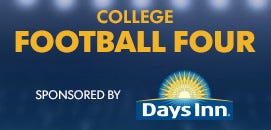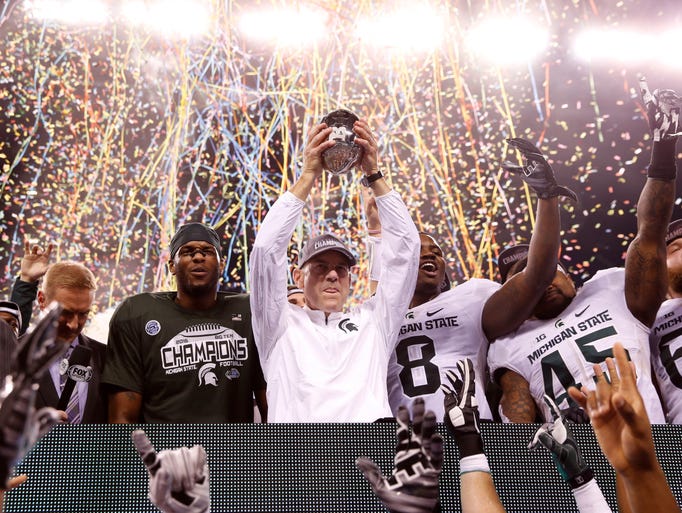At Michigan State and Oklahoma, revenue sports are four of a kind – USA TODAY
A little more than a month ago in early November, Michigan State athletic director Mark Hollis and Oklahoma’s Joe Castiglione were together in Glendale, Ariz., the host city of the Jan. 11 College Football Playoff championship game.
Hollis and Castiglione were there strictly on hoops duty. Castiglione is the chair of the Division I men’s basketball committee, and Hollis, his close friend, takes over the post next season, which culminates in Phoenix’s first time hosting the Final Four. The two flew to Arizona to conduct their first committee meeting of the season and to celebrate the beginning of the city’s Final Four preparations.
“That was before the run each of us had to finish the (football) season,” Castiglione told USA TODAY Sports. “Both of us have great imaginations, so we were thinking, ‘Wouldn’t it be great for both of us to be here playing on January 11th?’
“We were not getting ahead of ourselves by any means, any way, shape or form. There was still a lot of season left in front of us, but we at least had the vision of what could happen.”
The possibility still exists that Michigan State and Oklahoma can meet in the football title game, if the Spartans upset No. 2 Alabama in the Cotton Bowl and Oklahoma knocks off unbeaten No. 1 Clemson in the Orange Bowl. What seemed then like a longshot — that both a one-loss Oklahoma and one-loss Michigan State would win out and secure spots in the four-team field in the first place — has happened.
Meanwhile, both schools’ basketball teams also happen to be among the country’s best. Coach Tom Izzo’s Spartans are 11-0, ranked No. 1 in the nation and led by early national Player of the Year candidate Denzel Valentine. Lon Kruger’s Sooners jumped up to No. 3 in the latest USA TODAY Sports Coaches Poll, propelled by a 23-point win against Villanova on Dec. 7 and a 7-0 record.
The women’s basketball teams at each school also reside in their Coaches Poll, with Oklahoma at No. 18 and Michigan State at No. 23 entering Tuesday.
“It’s the town, the fan base, the community and the student-athletes who are having a blast; the athletic director is stressed out,” Hollis said. “You know, it’s a good thing. It’s what you compete for. Keeping that balance between two outstanding programs is a challenge at any level, but It’s neat to look at two programs that are really in smaller communities that are having those kind of successes in (two) sports. It’s something I don’t take for granted. We’re excited here in East Lansing.”
There’s the same level of enthusiasm in Norman, too. Castiglione said the part of the dual success he’s enjoying most right now is the players themselves, and their sheer joy. And the fact that Oklahoma’s success followed an offseason filled with outside criticism and some coaching staff adjustments after an 8-5 season.
“Mark and I talk all the time; we both know what our programs had to go through to get to this point,” Castiglione said. “It doesn’t happen automatically. Sometimes when people are really successful or really skilled, they can make it look easier than it really is. … Our journey to this point has been most challenging. I think about our team.
“They clearly came together for a real purpose. Who they are, what they want to accomplish. The average person doesn’t see that. The average person doesn’t see our team day to day, what they go through.”
Neither Hollis nor Castiglione lost much sleep over the impending release of the final Playoff rankings on Dec. 6. They both believed, with conference championships in hand, their teams would end up in the top four.
Throughout the season, though, they both kept tabs on their football teams and the rest of the college football landscape, often relying on their background on the basketball committee to weigh different variables and compare teams.
For example, Castiglione noted that, by season’s end, Oklahoma had played nine bowl teams. The team that gave the Sooners their lone loss, Texas, also upset Baylor to close out the regular season, which helped strengthen the Sooners’ case.
Hollis said after Michigan State lost to Nebraska, he didn’t think the Spartans’ chances were toast. Though individual wins and losses matter exponentially more in college football than in basketball, there were still plenty of other factors to consider.
“When we got the loss, it was one of those where you knew likely at the end of year there was going to be a one-loss team,” Hollis said. “It was going to go back to: Who did they play? Who did they beat?
“If there was any perspective that I was really viewing it from the basketball side, it was watching what Oregon did toward the end of the season, where they started to come back and see where some of those opportunities might develop to put Michigan State in a good place — Michigan having a good season, Oregon having a good season. It was kind of less about what we were doing — knowing we had to win out from that point — but also watching those teams that we had beaten throughout the year position themselves as pretty good teams as well.”
COLLEGE FOOTBALL PLAYOFF TEAMS’ SEASON HIGHLIGHTS





